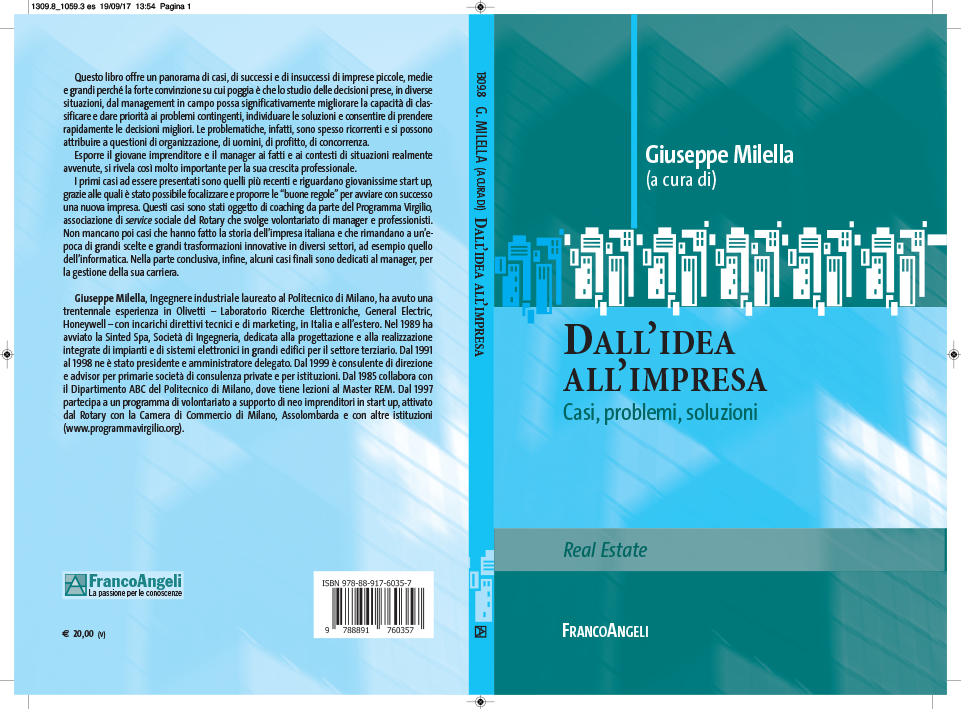La Formazione
Nel Programma Virgilio impegnato nella formazione ed assistenza ai neo imprenditori, sono disponibili i volumi
- “Costruire una nuova impresa. Cosa fare e come farlo.”
- “Dall’idea all’impresa”
Scritti da un tutore veterano del Programma Virgilio sulla base delle sue esperienza di imprenditore, manager e docente di Master al Politecnico di Milano,
“Costruire una nuova impresa. Cosa fare e come farlo.”
Costituisce un sintetico riferimento, come un vademecum, utile tanto al tutorando che al tutore. Oltre che descrivere in una logica successione i passi dello sviluppo della nuova impresa iniziando dal tempo zero, il libro si presta a consultazioni rapide su specifici argomenti quali il bilancio, i mercati, il prezzo. Fondamentali i punti trattati come formazione del valore, conduzione economica, manageriale e soprattutto mercato.
“Dall’idea all’impresa”
Questo libro offre un panorama di casi problematici, di successi e di insuccessi accaduti all’interno di imprese piccole, medie, grandi . I primi ad essere presentati sono anche i più recenti e riguardano le giovanissime startup seguite dal Programma Virgilio per le quali sono anche riassunte le buone regole per iniziare.
La pubblicazione curata da Franco Angeli Editore, ha già ottenuto qualificate recensioni.
Disponibili nelle migliori librerie


Education
The Program Virgilio being committed to train and to help the new entrepreneurs has made available in Italian the book “How to build a new enterprise. What to do and how to do it”. (orig. title ”Costruire una nuova impresa. Cosa fare e come farlo” – Franco Angeli, publisher – Italy – Feb. 2015). The book has been written by a veteran tutor of PV . The followings are the abstracts.
HOW TO BUILD A NEW ENTERPRISE by Giuseppe Milella
The book is essentially a synthetic reference manual likely a vademecum that can be useful both to the tutees and to the tutors. It offers an exhaustive guide about how to think, to build, to run a new enterprise or start up. It is based on author’s long personal experiences in multinational corporations , on his own experience as a founder of an advanced engineering company, as consultant and teacher at Master course Real Estate Management – ABC Department , Politecnico di Milano.
The content has a pragmatic approach : what to do, how to do it and when, in a logical sequence. Far from the academic language, the style is readable, yet a strong emphasis is given to the fundamental principles of economics that regulate any business (condicio sine qua non). Though the work is basically conceived to guide the first steps of the entrepreneur, its content could be useful to any person wishing to improve his knowledge about ruling a sound business and increase his chances of career in whichever organization.
The first observations focus on the motivations driving the entrepreneur and his potential partners. The initial process requires to run a feasibility study in a given market scenario, the results of which are thereafter conventionally organized into the business plan. Once the appreciation of the risks connected to the prospected business is achieved, the operations will start establishing the enterprise and defining the basic functions and responsibilities.
The operative and the subsequent economic plans shall describe beforehand what has to be performed in the first given period. The projected revenues and costs are analyzed as well as some basic accounting procedures to keep constantly close track of the business. The price setting of the product and the economic sustainability of the job (project-offer) to be presented to the customers are discussed as key matter to ensure the final result. The guidelines to prepare the balance sheet and the assets statement are outlined.
A main issue is to run a prudent simulation of events and costs in the first period, in order to evaluate the good margins and the capital requirements. Two business environments are considered and refer to: a) a good or service production as well as a construction enterprise and b) a software development house.
What to do in the very first days is a blank sheet: the best answer is to look for the first customers, to prepare the instruments and to go.
Which are the tools to manage the enterprise? A list of documents are described throughout the book and summarized in a quick reference chapter.
After the startup phase a few recommendations are provided, such as setting medium / long term objectives, innovation programs, relations with the stakeholder and the banks. Finally some considerations are dedicated to the different management styles and to the participative attitude in decision making process.
[:]